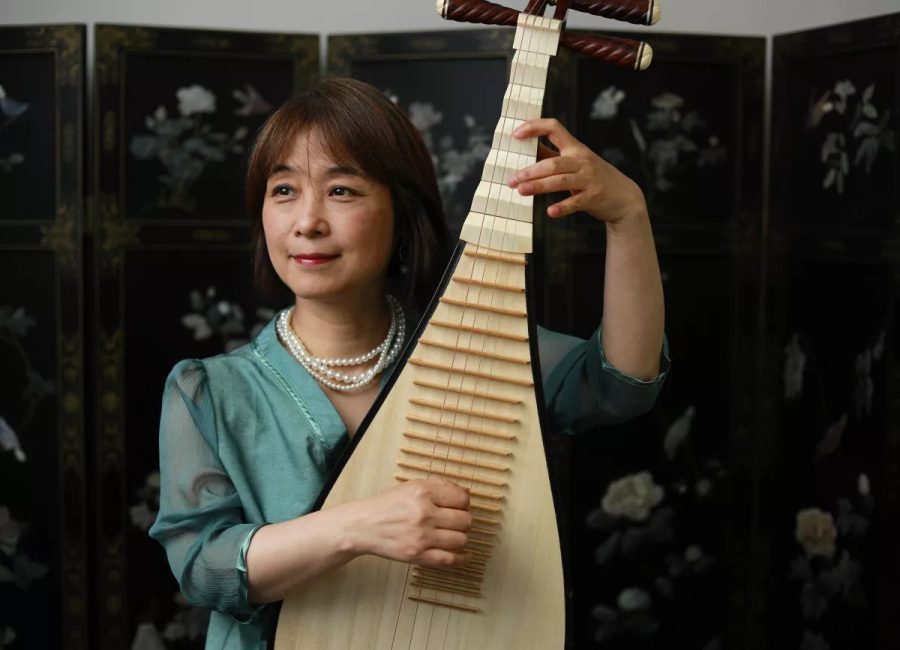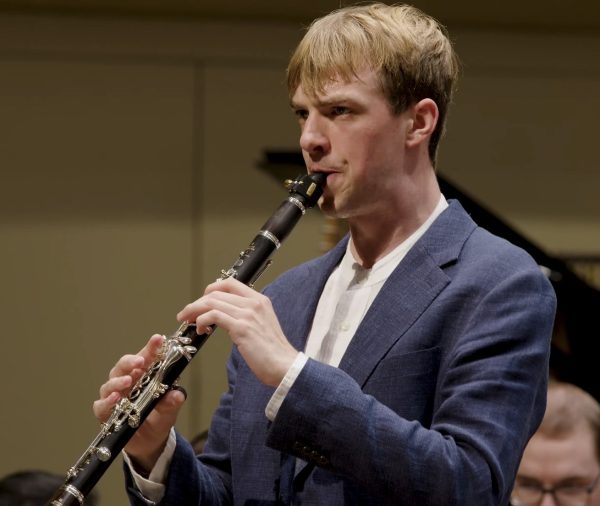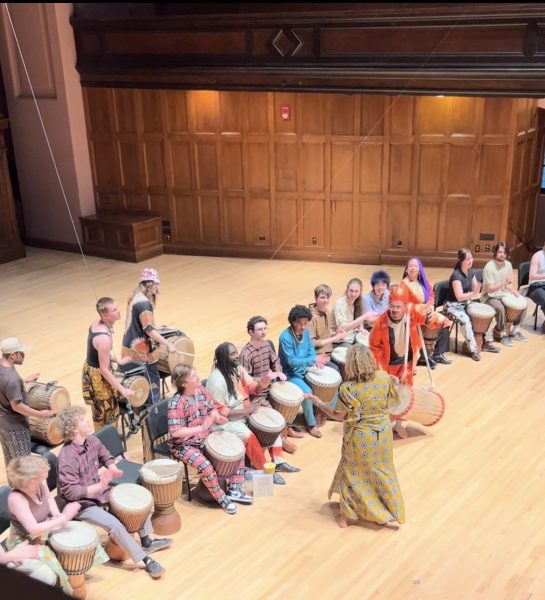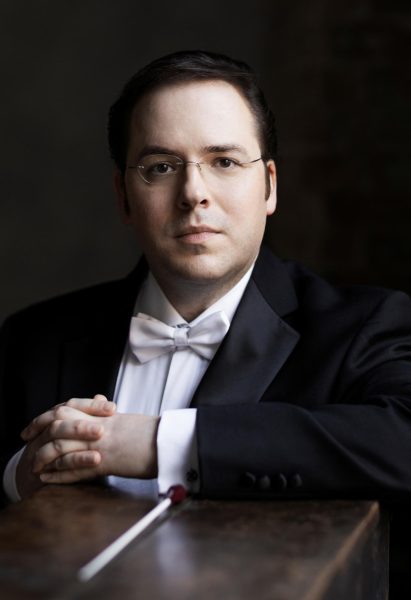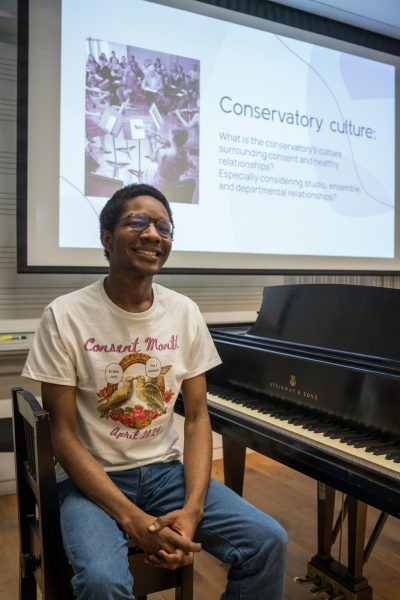Wu Man: Pipa Player, Musician Extraordinaire
Wu Man plays the pipa, a traditional Chinese instrument.
Wu Man is regarded as one of the world’s leading pipa performers and educators. The pipa is a 2,000-year-old, lute-like instrument that likely arrived in China by way of Central Asia. She will give a masterclass for students in the Performance and Improvisation Ensemble Saturday at 10:30 a.m. and will culminate her time at Oberlin with an evening performance in Warner Concert Hall with the Verona Quartet.
This interview has been edited for length and clarity.
What does it mean to you to play a 2,000-year-old instrument? What do you consider to be the most salient historical points of the pipa’s history?
Holding that instrument is like holding history. I’m holding a very modern version of my instrument, which is a very different version compared to 2,000 years ago. It’s very interesting to see how things have developed through all those years. The instrument came from Central Asia 2,000 years ago from Persia, and somehow it traveled and landed in the place that today they call China. So to me it’s not only the music, but also the history.
You mentioned that there are different materials for the modern instruments versus the traditional ones. What is the difference?
Well, the shape is still the same pear shape, but in ancient times they held it very much like a European or Middle Eastern lute, like horizontally. Also, the material of the string used to be silk. Now it’s metal. In the old days, you’d hold an animal bone to pluck the strings. Later on, they used natural fingernails, and now we use plastic-like fingernails. You have to put fingernails on all five fingers to play the instrument. There used to be less frets on the instrument. Now we have 20- or 30-something frets.
You also play pipa in non-traditional settings. Can you talk a bit about your introduction and inspiration for starting that sort of work?
I grew up with traditional music in China. The first repertoire for the pipa was notated in the 19th century, so we have less than 20 pieces because a lot was taught through oral tradition. After I learned all those 20-something pieces, I was like, “What’s next? What can I do if I want to play with other friends from different cultural backgrounds?” That’s how I became inspired by music from Africa, the Middle East, Central Asia, and of course Western classical music.
Does doing that kind of work influence the way that you play in more traditional settings? Does it change your relationship with the pipa in any way?
I don’t think it changes, but it adds up. It’s like when you have different kinds of nutrition instead of only having one kind of food you eat every day — you become more rich, musically. You learn the different styles and you learn the different rhythms, intonation, ornamentations, and languages. So when I come back to do my own tradition, a lot of the time I feel like now I have more language in my body.
I know that you did a documentary where you went to different towns in China and learned from their folk music traditions. What was that process like? What was the most surprising or inspiring thing that you learned?
Many people have asked me, “Tell me about Chinese music. What is Chinese music?” And it’s like I’m asking, “What is American music?” So, what is Chinese music? It’s not only the pipa. There are so many kinds of different genres and different art forms. So that’s what began my curiosity to visit the northern part of China.
There’s a lot of music rooted in their daily lives. They’re not what we call concert musicians. Some are farmers, but they’ve grown up with a family that plays music for the funeral, weddings, or the local festivals. There are a lot of traditional practices for funerals. If someone passes away in the wintertime, they will put the body in the coffin and keep it in the home until the funeral season or until winter passes. And then in March or April, they can do the ceremony. They start up the car and put the coffin in there and then there’s a whole ceremony with music.
To me, it’s also fascinating watching those instruments for the first time. When I was there, my eyes just couldn’t look away from them. I had to ask a lot of questions. That also tells me that the music, the culture, even in the same land, are very different.
I know you work a lot with string quartets. What is that process like and how has the process been with the Verona Quartet in particular?
I’m very much looking forward to working with the Verona Quartet. I have not met them personally yet — we just met them from a Zoom meeting — so I’m very excited. It’s going to be brand new.
Working with string quartets or with Western instruments in a chamber music setting or even improvising with other instruments is a part of my passion. I really enjoy it. Sometimes I don’t like to just play by myself. I want to work with them in some way. It’s like: How can we make a Western string quartet sound combined with Chinese traditional form? That’s a challenge. But to me that’s also great. I take that challenge.
Do you have any advice for students who want to broaden their musical experiences or get out of their musical comfort zone?
I think you have to know your instrument well. You have to know your instrument’s history, the language of the instrument, and the repertoire. And then once you have those foundations, you can fly. I think, especially for the younger generation, if you only play one kind of music, you will not survive as a musician in the future. That’s my experience.
Are there any genres of music that you haven’t explored that are on your bucket list?
Rock and roll. If you’re talking about musical performance, that’s the area I haven’t done. You know, like pop. I listen to pop songs and kind of try to understand the musical arrangement, the instrumentation, the colors of the instruments, the sound. Pipa is like a guitar, like a bass. It could definitely do a lot of the same kind of material.


